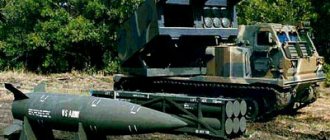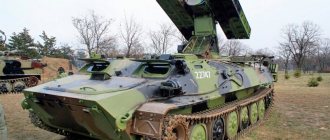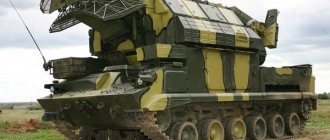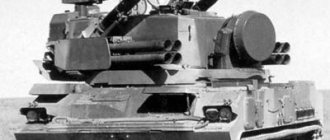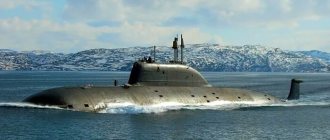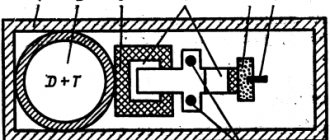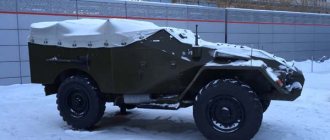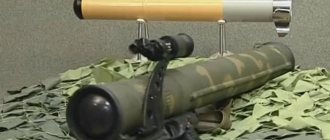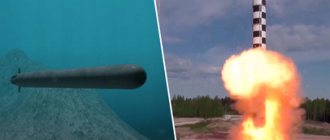Combat vehicle 9P148
Main article
9P148 “Competition” Launcher 9P148
Launcher body 9P148
The Konkurs ATGM is modified in relation to the basic
BRDM-2
.
The changes ensure the placement of the launcher, sighting device, as well as electric drives for their guidance and synchronization. A cutout was made in the original body roof sheet for the exit of the launch guides. The cutout is covered by a rectangular electrically operated hatch. The commander's hatch contains a 9Sh119
with the ability to quickly move roughly manually along the horizon, or smoothly track the target using an electric drive. The sight in the stowed position is closed by an armored shutter with a manual drive. In order to protect the optics, there is a “combat glass” that is opened only during combat work, also manually. A light filter is provided to protect the gunner's vision from the effects of light radiation from a nuclear explosion, laser radiation, etc. The filter drive is also manual.
Launcher 9P135
Launch guides on the roof of the 9P148 hull
Hardware part of the 9P148
made on the basis of portable installation units
9P135
placed in the housing.
Also included in the kit is a 9P56
from the portable version. Thus, it is possible to fully use the anti-tank system outside the combat vehicle, for which it is necessary to dismantle the sighting device, control equipment, remove the machine from the stack and assemble the launcher. No special tools are required for this - all blocks are secured with wing nuts, the sight is removed upward through a special hatch in its turret using a standard turret key.
In addition to standard installation blocks 9P135
, the BM “Competition” contains special blocks:
- light interference indication unit (allows you to detect light interference that interferes with the semi-automatic guidance of the missile at the target);
- built-in equipment for monitoring and testing starting circuits;
- electromechanical guidance and synchronization drives.
The ability to test start-up circuits allows you to check the performance of the entire start-up procedure chain without actually starting up the products. Since the recoilless principle is used to launch a rocket, the launch is accompanied by the emission of a flame torch from the end of the container at approximately 10-15 m. In this regard, reliable insulation of the engine and combat compartments from the effects of flame is extremely important. Checking the start-up circuits allows you to diagnose malfunctions of the air intake protective shutter reset mechanism, breaks in the lines of the limit switches of the “travelling” locking mechanisms and the signaling for closing crew hatches and weapons.
ATGMs 9M14P1, 9M113M and 9M113 in the Tula State Museum of Weapons
Missiles of the 9M113
, 9M111 (and their modifications) are widely described in the literature. The startup process deserves a separate description. Complicated at first glance, it ensures the product is launched only after all the procedures necessary for a reliable start have been fully worked out, and excludes the product from being launched in the event of any malfunctions.
- When the operator presses the “start” button, the electrical circuit of the squib of the hinged front cover of the TPK is closed, the cover opens, releasing the push rod of the squib contact of the power supply compartment (it also contains the Ш9 connector, which ensures switching of the electrical circuits of the rocket and the combat vehicle).
- Under the influence of the squib pulse, the separated batteries close and supply power to the on-board network of the product. The gyro powder generator ignites. After spinning up the gyroscope to operating speed (about 10,000 rpm), the inertial contactor switches the fuse of the expelling charge.
- The expelling charge ignites, pushing the product out of the TPK.
- Rocket length (with ejector): 1165 mm
- Length of TPK with rocket: 1260—1263 mm
- Diameter: 135 mm
- Wingspan: 468 mm
- Firing range: during the day - 75-4000 m
- at night - 75-3500 m
- Weight of portable PU 9P135: 22 kg
- Rocket launch weight: 14.5 kg (<=17 kg 9M113M[6])
- Missile mass in TPK: 25.3 kg (<=27.4 kg 9M113M[6])
- Weight of cumulative warhead: 2.7 kg
- Average rocket flight speed: ~208 m/s
- Armor penetration:
- at an angle of 60° - 250 mm
- at an angle of 90°, with a probability of 0.5 - 750-800 mm for 9M113M Operators of the Konkurs ATGM
Azerbaijan - 20 9P148 combat vehicles and 400 9M113 missiles [7] - Algeria - a number of 9K111-1 “Competition” complexes, as of 2010[8],
- Armenia - 9 9P148 combat vehicles, as of 2016[9]
- Belarus - a number of 9K111-1 “Konkurs” complexes, as of 2010[10]
- Bulgaria - 236 9K111 "Fagot" and 9K111-1 "Konkurs" complexes, as of 2010[11], 400 9M113 ATGMs were produced under license for the BMP-30 in the period from 1988 to 1996[12]
- Hungary - 100 combat vehicles and 2060 9M113 missiles were supplied from the USSR between 1974 and 1988[12], as of 2010, 100 9K111-1 “Konkurs” complexes are still in service[13]
- Guinea - a number of 9M113 ATGMs, as of 2010[14]
- Georgia - a certain amount of 9M113, as of 2017[15]
- GDR - 52 9P148 combat vehicles were supplied from the USSR in the period from 1980 to 1983[12], 11,200 9M113 missiles were supplied from the USSR in the period from 1980 to 1989[12]
- Egypt - 580 9M113 missiles for Fahd armored personnel carriers were supplied from Russia between 1992 and 1995[12]
- India - 110 SPTRK based on BRDM-2 with 9M111 and 9M113 missiles (presumably 9P148), as of 2010[16], 1000 9M113 missiles were supplied from the USSR in the period from 1989 to 1991[12]. 25,000 9M113 missiles were ordered from the USSR in 1988, produced under license since 1992 (including the 9M113M version), as of 2011, 12,800 missiles were produced[12]
- Iraq - were in service with the Iraqi army during the Gulf War[17]
- Iran - a certain number of 9K111-1 “Konkurs” complexes, as of 2010[18], missiles are produced under license under the designation Towsan-1, in the period from 1999 to 2011 2400 units of 9M113 were produced[12]
- Kazakhstan - a number of 9K111-1 “Konkurs” complexes, as of 2010[19]
- Kyrgyzstan - 12 units 9K111-1 “Competition”, as of 2016 [20][21]
- DPRK - a number of 9K111-1 “Konkurs” complexes, as of 2010[22]
- Cote d'Ivoire - a number of 9K111-1 "Competition" complexes, as of 2010[23]
- Libya - a number of 9K111-1 “Konkurs” complexes, as of 2010[24]
- Moldova - 19 9K111-1 “Competition” complexes, as of 2010[25]
- Morocco - 100 9M113 missiles delivered from Russia in 2001[12]
- Poland - 800 9M113 missiles were supplied from the USSR between 1987 and 1989[12], as of 2010, 18 9K111-1 “Konkurs” complexes are still in service[26]
- Russia: Ground Forces of the Russian Federation - a number of 9K111-1 “Konkurs” complexes, as of 2010[27]
- Coastal troops of the Russian Navy - 72 complexes 9K11 "Malyutka" and 9K111-1 "Konkurs", as of 2010[28]
- Romania - 48 units 9P148, as of 2010[29]
- Syria - 400 9M113 missiles were supplied from the USSR between 1984 and 1987[12], as of 2010, 40 9K111-1 “Konkurs” complexes are still in service[30]
- Slovakia - 425 complexes 9K11 “Malyutka” and 9K111-1 “Konkurs”, as of 2010[31]
- USSR
- Turkmenistan - a number of 9K111-1 “Konkurs” complexes, as of 2010[32]
- Montenegro - 19 complexes 9K111-1 “Konkurs”, as of 2010[33]
- Czech Republic - 21 units 9P148, as of 2010[34]
- Ukraine - a number of 9K111-1 “Konkurs” complexes, as of 2010[35]
- Finland - 520 9M113 missiles for the BMP-2 were supplied from the USSR and Russia from 1988 to 1992[12]
- Eritrea - 200 complexes 9K11 “Malyutka” and 9K111-1 “Konkurs”, as of 2010[36]
Compound
Combat vehicle 9P148
Main article
9P148 “Competition” Launcher 9P148
Launcher body 9P148
The Konkurs ATGM is modified in relation to the basic
BRDM-2
.
The changes ensure the placement of the launcher, sighting device, as well as electric drives for their guidance and synchronization. A cutout was made in the original body roof sheet for the exit of the launch guides. The cutout is covered by a rectangular electrically operated hatch. The commander's hatch contains a 9Sh119
with the ability to quickly move roughly manually along the horizon, or smoothly track the target using an electric drive. The sight in the stowed position is closed by an armored shutter with a manual drive. In order to protect the optics, there is a “combat glass” that is opened only during combat work, also manually. A light filter is provided to protect the gunner's vision from the effects of light radiation from a nuclear explosion, laser radiation, etc. The filter drive is also manual.
Launcher 9P135
Starting guides on the roof of the 9P148 housing
Hardware part of the 9P148
made on the basis of portable installation units
9P135
placed in the housing.
Also included in the kit is a 9P56
from the portable version. Thus, it is possible to fully use the anti-tank system outside the combat vehicle, for which it is necessary to dismantle the sighting device, control equipment, remove the machine from the stack and assemble the launcher. No special tools are required for this - all blocks are secured with wing nuts, the sight is removed upward through a special hatch in its turret using a standard turret key.
In addition to standard installation blocks 9P135
, the BM “Competition” contains special blocks:
- light interference indication unit (allows you to detect light interference that interferes with the semi-automatic guidance of the missile at the target);
- built-in equipment for monitoring and testing starting circuits;
- electromechanical guidance and synchronization drives.
The ability to test start-up circuits allows you to check the performance of the entire start-up procedure chain without actually starting up the products. Since the recoilless principle is used to launch a rocket, the launch is accompanied by the emission of a flame torch from the end of the container at approximately 10-15 m. In this regard, reliable insulation of the engine and combat compartments from the effects of flame is extremely important. Checking the start-up circuits allows you to diagnose malfunctions of the air intake protective shutter reset mechanism, breaks in the lines of the limit switches of the “travelling” locking mechanisms and the signaling for closing crew hatches and weapons.
ATGM 9M113
ATGMs 9M14P1, 9M113M and 9M113 in the Tula State Museum of Weapons
Missiles of the 9M113
, 9M111 (and their modifications) are widely described in the literature. The startup process deserves a separate description. Complicated at first glance, it ensures the product is launched only after all the procedures necessary for a reliable start have been fully worked out, and excludes the product from being launched in the event of any malfunctions.
- When the operator presses the “start” button, the electrical circuit of the squib of the hinged front cover of the TPK is closed, the cover opens, releasing the push rod of the squib contact of the power supply compartment (it also contains the Ш9 connector, which ensures switching of the electrical circuits of the rocket and the combat vehicle).
- Under the influence of the squib pulse, the separated batteries close and supply power to the on-board network of the product. The gyro powder generator ignites. After spinning up the gyroscope to operating speed (about 10,000 rpm), the inertial contactor switches the fuse of the expelling charge.
- The expelling charge ignites, pushing the product out of the TPK.
- The main engine is ignited by its own inertial contactor after the missile reaches a speed of about 300 m/s (which occurs at a distance of approximately 70 m from the firing position).
Anti-tank generations
The Germans were the first to develop anti-tank guided missiles (ATGMs) back in the middle of World War II. By 1945, the Ruhrstahl company had managed to produce several hundred units of the Rotkappchen (“Little Red Riding Hood”) ATGM.
After the end of the war, these weapons fell into the hands of the Allies, and they became the basis for the development of their own anti-tank systems. In the 50s, French engineers managed to create two successful missile systems: SS-10 and SS-11.
Only a few years later, Soviet designers began developing anti-tank missiles, but already one of the first examples of Soviet ATGMs became an undoubted world bestseller. The Malyutka missile system turned out to be very simple and very effective. In the Arab-Israeli war, with its help, up to 800 armored vehicles were destroyed in a few weeks (Soviet data).
All of the above ATGMs belonged to first-generation weapons; the missile was controlled by wire, its flight speed was low, and its armor penetration was low. But the worst thing was something else: the operator had to control the rocket throughout its flight, which placed high demands on his qualifications.
In the second generation of ATGMs, this problem was partially solved: the complexes received semi-automatic guidance, and the missile's flight speed was significantly increased. The operator of these anti-tank missile systems simply had to point the weapon at the target, fire a shot, and keep the object in the crosshairs until the missile hit. Its control was taken over by a computer that was part of the missile complex.
The second generation of these weapons includes the Soviet ATGMs “Fagot”, “Konkurs”, “Metis”, the American TOW and Dragon, the European Milan complex and many others. Today, the overwhelming majority of samples of these weapons, which are in service with various armies of the world, belong to the second generation.
Since the beginning of the 80s, the development of the next, third generation ATGM began in different countries. The Americans have made the most progress in this direction.
A few words should be said about the concept of creating a new weapon
This is important, because the approaches of Soviet and Western designers were very different
In the West, they began to develop anti-tank missile systems that operate on the “fire and forget” principle. The operator’s task is to aim the missile at the target, wait for it to be captured by the missile homing head (GOS), fire and quickly leave the launch site. The smart rocket will do the rest itself.
An example of an ATGM that operates on this principle is the American Javelin complex. The missile of this complex is equipped with a thermal homing head, which reacts to the heat generated by the power plant of a tank or other armored vehicle. There is one more advantage that ATGMs of this design have: they can hit tanks in the upper, most unprotected projection.
However, in addition to undeniable advantages, such systems also have serious disadvantages. The main one is the high cost of the rocket. In addition, a missile with an infrared seeker cannot hit an enemy bunker or firing point, the range of use of such a complex is limited, and the operation of a missile with such a seeker is not very reliable. It is only capable of hitting armored vehicles with the engine running, which have a good thermal contrast with the surrounding terrain.
In the USSR they took a slightly different path; it is usually described with the slogan: “I see and shoot.” It is on this principle that the newest Russian ATGM “Kornet” operates.
After the shot, the missile is aimed at the target and kept on its trajectory using a laser beam. In this case, the missile's photodetector is facing the launcher, which ensures high noise immunity of the Kornet missile system. In addition, this ATGM is equipped with a thermal imaging sight, which allows it to fire at any time of the day.
This method of guidance seems anachronistic compared to foreign third-generation ATGMs, but it has a number of significant advantages.
Performance characteristics
- Rocket length (with ejector): 1165 mm
- Length of TPK with rocket: 1260—1263 mm
- Diameter: 135 mm
- Wingspan: 468 mm
- Firing range: during the day - 75-4000 m
- at night - 75-3500 m
- at an angle of 60° - 250 mm
Launchers
Kornet-D on the VPK-233116 chassis.
- 9P161 -
Self-propelled ATGM 9K128 Kornet-S on the BMP-3 chassis with two launchers, each with 1 guide and automatic loader
. - 9P162 -
Self-propelled ATGM 9K128-1 Cornet-T on the BMP-3, BTR-80 chassis with two launchers, each with 1 guide and automatic loader
. - 9P162M -
Self-propelled ATGM Kornet-D1 on the BMD-4M chassis
. - 9P163 -
Portable ATGM 9K129 Cornet-P with 1 guide
. - 9P163-1 -
Portable ATGM 9K129-1 Cornet-P with 1 guide.
Experienced self-propelled ATGM 9K135 Vest on a UAZ-3151 chassis with 4 guides and an automatic loader . - 9P163-2 Quartet -
Combat module of the Kornet\Kornet-E ATGM with 4 guides and an automatic loader for placement on light carriers
. - 9P163-2M Quartet-M -
Combat module of the Kornet-D\EM ATGM with 4 guides and an automatic loader for placement on light carriers
. - 9P163-3 -
Self-propelled ATGM Kornet-D1\EM on the VPK-233116\VPK-233136 Tiger-M chassis with two launchers, each with 4 guides and an automatic loader. - 9P163M-1 -
Portable and portable ATGM Kornet-P\E with 1 guide
. - 9P163M-2 -
Portable and portable ATGM Kornet-D\EM with 1 guide
.
Operators
- Azerbaijan22x20px Azerbaijan - 20 9P148 combat vehicles and 400 9M113 missiles [5]
- Algeria22x20px Algeria - a number of 9K111-1 “Konkurs” complexes, as of 2010[6],
- Armenia22x20px Armenia - 9 9P148 combat vehicles, as of 2016[7]
- Belarus22x20px Belarus - a number of 9K111-1 “Konkurs” complexes, as of 2010[8]
- Bulgaria22x20px Bulgaria - 236 9K111 "Fagot" and 9K111-1 "Konkurs" complexes, as of 2010[9], 400 9M113 ATGMs were produced under license for the BMP-30 in the period from 1988 to 1996[10]
- Hungary22x20px Hungary - 100 combat vehicles and 2060 9M113 missiles were delivered from the USSR between 1974 and 1988[10], as of 2010, 100 9K111-1 “Konkurs” complexes are still in service[11]
- Guinea22x20px Guinea - a number of 9M113 ATGMs, as of 2010[12]
- Georgia22x20px Georgia - some number of 9M113, as of 2020[13]
- GDR22x20px GDR - 52 9P148 combat vehicles were supplied from the USSR in the period from 1980 to 1983[10], 11,200 9M113 missiles were supplied from the USSR in the period from 1980 to 1989[10]
- Egypt22x20px Egypt - 580 9M113 missiles for Fahd armored personnel carriers were supplied from Russia between 1992 and 1995[10]
- India22x20px India - 110 SPTRK based on BRDM-2 with 9M111 and 9M113 missiles (presumably 9P148), as of 2010[14], 1000 9M113 missiles were supplied from the USSR in the period from 1989 to 1991[10]. 25,000 9M113 missiles were ordered from the USSR in 1988, produced under license since 1992 (including the 9M113M version), as of 2011, 12,800 missiles were produced[10]
- Iraq22x20px Iraq - were in service with the Iraqi army during the Gulf War[15]
- Iran22x20px Iran - a certain number of 9K111-1 “Konkurs” complexes, as of 2010[16], missiles are produced under license under the designation Towsan-1, in the period from 1999 to 2011 2400 units of 9M113[10] were produced
- Kazakhstan22x20px Kazakhstan - a number of 9K111-1 “Konkurs” complexes, as of 2010[17]
- Kyrgyzstan22x20px Kyrgyzstan - 12 units 9K111-1 “Competition”, as of 2020 [18][19]
- DPRK22x20px DPRK - a number of 9K111-1 “Konkurs” complexes, as of 2010[20]
- Cote d'Ivoire22x20px Cote d'Ivoire - a number of 9K111-1 "Competition" complexes, as of 2010[21]
- Libya22x20px Libya - a number of 9K111-1 “Konkurs” complexes, as of 2010[22]
- Moldova22x20px Moldova - 19 9K111-1 “Konkurs” complexes, as of 2010[23]
- Morocco22x20px Morocco - 100 9M113 missiles delivered from Russia in 2001[10]
- Poland22x20px Poland - 800 9M113 missiles were supplied from the USSR between 1987 and 1989[10], as of 2010, 18 9K111-1 “Konkurs” complexes are still in service[24]
- Russia22x20px Russia: Ground Forces of the Russian Federation - a number of 9K111-1 “Konkurs” complexes, as of 2010[25]
- Coastal troops of the Russian Navy - 72 complexes 9K11 "Malyutka" and 9K111-1 "Konkurs", as of 2010[26]
Template:Columns
Combat use of the complex
The first serious conflict in which the Kornet complex was used was the war in Lebanon in 2006. The Hezbollah group actively used this anti-tank system, which practically thwarted the offensive of the Israeli army. According to the Israelis, 46 Merkava tanks were damaged during the fighting. Although, not all of them were shot down from the Kornet. Hezbollah received these ATGMs through Syria.
According to Islamists, Israel's losses were actually much greater.
In 2011, Hezbollah used a Kornet to target an Israeli school bus.
During the civil war in Syria, many units of these weapons from looted government arsenals fell into the hands of both the moderate opposition and ISIS units (an organization banned in the Russian Federation).
During Operation Protective Edge, most of the anti-tank missiles fired at Israeli tanks were various modifications of the Kornet. All of them were intercepted by the Trophy active tank defense. The Israelis took several complexes as trophies.
In Yemen, the Houthis have very successfully used this anti-tank system against Saudi Arabian armored vehicles.
Notes
- , With. 187.
- , With. 174.
- Spandrel
literally means “above structure”, “sinus of the vault”. - ↑
- ↑. Official website of the Tula Arms Plant. Retrieved January 27, 2013.
- The Military Balance 2010. - P. 176.
- The Military Balance 2010. - P. 245.
- The Military Balance 2020. - P. 178.
- The Military Balance 2010. - P. 178.
- The Military Balance 2010. - P. 122.
- ↑ Error in footnotes?: Invalid tag ; no text provided for footnotes
- The Military Balance 2010. - P. 140.
- The Military Balance 2010. - P. 311.
- The Military Balance 2020. - P. 205.
- The Military Balance 2010. - P. 360.
- . MESHWAR. Retrieved August 21, 2012.
- The Military Balance 2010. - P. 251.
- The Military Balance 2010. - P. 365.
- The Military Balance 2020, p.187
- The Military Balance 2010. - P. 412.
- The Military Balance 2010. - P. 302.
- The Military Balance 2010. - P. 262.
- The Military Balance 2010. - P. 188.
- The Military Balance 2010. - P. 153.
- The Military Balance 2010. - P. 223.
- The Military Balance 2010. - P. 227.
- The Military Balance 2010. - P. 157.
- The Military Balance 2010. - P. 272.
- The Military Balance 2010. - P. 159.
- The Military Balance 2010. - P. 372.
- The Military Balance 2010. - P. 189.
- The Military Balance 2010. - P. 125.
- The Military Balance 2010. - P. 196.
- The Military Balance 2010. - P. 307.
Control
Characteristics of ATGMs with tandem warheads
| Complex | Control system |
| "Arcan" | I'll get a laser |
| "Zenith" | on the radio |
| "Invar" | by laser beam |
| "Metis-M" | by wire |
| "Attack" | on the radio |
| "Konkurs-M" | by wire |
| "Whirlwind-M" | by laser beam |
| "Chrysanthemum" | by radio and laser beam |
| "Cornet" | by laser beam |
Design and principle of operation
The ATGM is triggered in the following steps:
- The operator visually points the complex at the target using an optical sight. The ATGM itself cannot detect and track targets, so it is considered semi-automatic.
- The operator gives the command to launch the ATGM and the ejector motor fires.
- The 9M111 missile, having left the ATGM, straightens the rudders made of thin stainless steel, which simply due to their elasticity collapse when inserted into the TPK.
- Behind the rocket, the control wire begins to unwind from the coil.
- After the ATGM has left the ATGM, a protective curtain with a lamp in the rear of the missile opens.
- The 9Sh119M1 optical receiver on the ATGM detects the angular coordinates of the ATGM based on the operation of the lamp and begins to issue commands over the wire to keep the ATGM on the aiming line. The 9Sh119M1 receiver can also inform the operator if the target is trying to interfere with light during the flight of an ATGM.
- The missile sends commands received from the ATGM to the rudders using electromagnetic drives. Moreover, when issuing commands, the rocket also uses data from the gyroscope built into it to take into account its current angular orientation in space. The rocket's flight path is a spiral.
- Since the ATGM does not see the target itself, but only follows the operator’s sight, the operator himself needs to keep the target in sight if it moves, which requires special training.
t3
Characteristics of ATGMs with tandem warheads
| Complex | t3, ISS |
| "Arcan" | 300 |
| "Zenith" | 150 |
| "Invar" | 300 |
| "Metis-M" | 300 |
| "Attack" | 220 |
| "Konkurs-M" | 250 |
| "Whirlwind-M" | 300 |
| "Chrysanthemum" | 250 |
| "Cornet" | 300 |
Note: b0 is the armor penetration of the main charge of a tandem warhead; t3 - delay time between detonations of the leading and main warhead charge
Index
Characteristics of ATGMs with tandem warheads
| Complex | BC index |
| "Arcan" | 9N136M1 |
| "Zenith" | 9N149 |
| "Invar" | 9N142M |
| "Metis-M" | 9N154 |
| "Attack" | 9N143 |
| "Konkurs-M" | 9N131M1 |
| "Whirlwind-M" | — |
| "Chrysanthemum" | 9N146 |
| "Cornet" | 9N156 |
b0
Characteristics of ATGMs with tandem warheads
| Complex | b0, mm |
| "Arcan" | 700 |
| "Zenith" | 700 |
| "Invar" | 700 |
| "Metis-M" | 850 |
| "Attack" | 800 |
| "Konkurs-M" | 800 |
| "Whirlwind-M" | 850 |
| "Chrysanthemum" | 1000 |
| "Cornet" | 1000 |
Note: b0 is the armor penetration of the main charge of a tandem warhead; t3 - delay time between detonations of the leading and main warhead charge
The complex consists of a 9P148 combat vehicle (carrier) with a 9P135M1 type launcher (PU) mounted on it, and 9M113M guided missile ammunition. If necessary, the launcher and ammunition can be quickly removed and removed from the combat vehicle for autonomous firing. The missile control system is semi-automatic, with commands transmitted via a wired communication line. Combat crew - 2 people. The launcher is equipped with a 9Sh119M1 sighting device and a 1PN65 or 1PN86-1 “Mulat” thermal imaging device. To monitor the launcher, missile and thermal imager during storage and operation, testing equipment 9V812M-1, 9V811M, 9V974, integrated with the “Fagot” complex, is used. The missile is stored in a sealed transport and launch container (TPC) in constant combat readiness.
The Fagot (9M111, 9M111M) and Konkurs (9M113) anti-tank missiles can be used as ammunition. When changing the type of missiles, the operator's actions do not change. Armored wheeled and tracked combat vehicles are also used as carriers: BMP-1, BMP-2, BMD, BTRD, BRDM-2, MT-LB, light jeep-type vehicles, motorcycles and other carriers.
Rocket
Characteristics of ATGMs with tandem warheads
| Complex | Rocket |
| "Arcan" | 9M117M1 |
| "Zenith" | 9M128 |
| "Invar" | 9M119M |
| "Metis-M" | 9M131 |
| "Attack" | 9M120D |
| "Konkurs-M" | 9M113M |
| "Whirlwind-M" | 9А4172К |
| "Chrysanthemum" | 9M123 |
| "Cornet" | 9M133 |
Modifications
Sturm-V
Mi-24V of the Polish Army Aviation with two Sturm aircraft
"Sturm-V"
- aviation anti-tank missile system.
Both complexes use the same weapons - 9M114, 9M114M and 9M114F missiles. Currently, the complex allows the use of improved Attack missiles - 9M120-1, 9M120-1F, 9M120
,
9M120F
, 9A2200 and 9M2313. The missile system was put into service on March 28, 1976 and became the main weapon of the serial Mi-24V helicopters. Initially, 4 ATGMs were installed on the Mi-24, after modifications in 1986, up to 16 ATGMs were installed on the Mi-24. It is also used as part of the armament of the Mi-24P, Mi-24PV, as well as Ka-29 helicopters. The new Mi-28 combat helicopter is also equipped with the Sturm missile system, which can carry up to 16 missiles on two launchers. The Ka-52 helicopter is equipped with the 9K113U Shturm-VU complex with 9M120-1, 9M120-1F missiles and a laser beam guidance system.
Shturm-S
Sturm-S in Patriot Park.
"Sturm-S"
- self-propelled anti-tank missile system.
The complex includes: a 9P149 combat vehicle, a 9M114 Sturm guided missile or an improved 9M120
, 9M120-1, 9M120-1F missile, maintenance equipment and training facilities. The Sturm and Ataka guided missiles can be equipped with a high-explosive or cumulative warhead; "Attack" can also be supplied with .
To control fire, special programs have been developed that allow the missile to initially fly both along the line of sight and along a trajectory above the line of sight, and when approaching the tank at a distance of 1000-1500 meters, it descends and hits the target (“Dust” mode). This allows the operator, regardless of weather conditions and the operation of the rocket engines, and when firing on loess soils, to always see the target. At the maximum firing range, the accuracy of the ATGM control system does not exceed 0.6 arc minutes. This allows you to fire at any small armored targets and even helicopters in hover and approach mode. The maximum altitude for hitting air targets (launch at sea level) is 3000 meters. The maximum altitude of use relative to sea level is at least 4000 meters.
The complex has been modernized to enable shooting at night and is produced under the name “Sturm-SME”.
Sturm-SM
In 2012, state tests of the modernized 9K132 complex (code “Shturm-SM”) were completed, and in June 2014 the complex was adopted by the Russian Armed Forces. The main differences are that the complex received a thermal television sight, which allows the complex to be successfully used at night and in adverse conditions (snow, rain, fog, etc.). The missile's flight range has also been increased: from 5 to 6 kilometers; a new high-explosive fragmentation warhead with a proximity fuse has been obtained, which allows it to successfully hit not only armored vehicles, but also enemy personnel.
Performance characteristics of Sturm-S
Main article: 9P149
- Chassis - amphibious tracked tractor MT-LB
- Weight of combat vehicle 9P149
: 12 t - Calculation: 2 people.
- Speed of targets hit: flank - up to 60 km/h
- frontal - up to 80 km/h
- Maximum ATGM 9M114 - 650 mm
- with a thrust of 760 kg - 2 sec.
History of creation
In the mid-60s of the last century, the leadership of the Soviet armed forces recognized the need to develop a new generation self-propelled anti-tank missile system. The Shmel and Phalanx ATGMs, which were in service with the SA at that time, clearly no longer met the requirements of the time.
The military needed an ATGM with a semi-automatic control system and a supersonic missile, with a target range of at least 4 kilometers. In addition, strict restrictions on the cost of the complex were imposed on the developers. The Kolomna Mechanical Engineering Design Bureau and the Instrument Engineering Design Bureau (Tula) took part in the competition.
The Kolomna designers tried to strictly follow all the customer’s wishes, and the Tula Bureau approached the task more creatively. Tula designers assessed the feasibility of each item of the task proposed by the military. As a result, they created a subsonic missile (ATGM), which was controlled in flight by wire, while significantly making it lighter and cheaper. In addition, the new missile system was highly unified with the Fagot ATGM.
Initially, the project to develop a new regimental ATGM was called “Oboe”, but the resulting complex was very different in its characteristics from the technical specifications, so they decided to change its name. The new ATGM was named “Competition”.
Testing and development of the new anti-tank missile system lasted several years. The Konkurs ATGM was put into service in 1974. This complex is largely unified with the Fagot ATGM; from its launcher you can launch Fagot ATGMs.
A few years later, work began on modernizing the “Competition”
The main attention was paid to the anti-tank missile, the designers tried to make its guidance fully automatic. ATGM testing began in 1983 and continued for several years.
In 1986, they decided to put Konkurs-R into service, but a little earlier they stopped producing the BRDM-2, which was the main combat vehicle (BM) for this complex.
At the end of the 80s, a more advanced modification of this missile system, Konkurs-M, was developed. Its main difference was a new missile with a tandem warhead, which significantly increased armor penetration and allowed the Konkurs-M to successfully fight armored vehicles equipped with dynamic protection. In addition, to install the Konkurs-M, you can use not only the BRDM-2, but also other combat vehicles: infantry fighting vehicles, infantry fighting vehicles, armored vehicles and even motorcycles.
